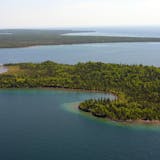A "Hail Mary type of concept" that "will exacerbate erosion and slope failure and will eventually fail." That's a description of the plan for storing mining waste at the proposed PolyMet mine in northeast Minnesota.
These descriptions come not from a mining opponent, but from a mining consultant hired by the Minnesota Department of Natural Resources (DNR) to evaluate the PolyMet proposal. These comments are only one of many troubling indicators that the current permit for mining is deeply flawed.
In Minnesota, the PolyMet mining proposal has created significant division between advocates for the mine and advocates for the environment. Gov. Mark Dayton has attempted to bridge that divide, saying that we can have mining and protect the environment, as long as we use best practices for mining and provide "safeguards" to prevent damage. Jon Cherry, the CEO of PolyMet, has committed to "meet or exceed regulatory standards and industry best practices."
Those commitments outline what could be a good compromise — one that could bring both sides of this contentious issue together: Allow the PolyMet mine to proceed, but only if it uses best practices. Unfortunately, the draft permit, which appears to be nearing DNR approval, fails this test and lacks the safeguards called for by the governor.
Let's not delude ourselves into believing that Minnesota has strong environmental standards for mines. The DNR mining consultant, Don Sutton of Spectrum Engineering, said: "I am surprised that the Minnesota Statutes allow a temporary [tailings] impoundment structure to be permitted permanently. This wouldn't be allowed in other jurisdictions." [Emphasis added.]
Sutton also brought up concerns about the long-term instability of the waste rock "tailings" pond banks from erosion, and calls the risk of long-term failure of the dam an "almost certainty." He explained that because of this erosion, "at some point the entire mass will unravel."
Why does this matter? A similar mining operation in British Columbia had a catastrophic dam failure in 2014 that released a toxic slurry of waste rock in one of the worst environmental disasters in Canadian history.
After that Mount Polley mine disaster in British Columbia, a comprehensive review called for dry storage of mine tailings as a best practice, along with a requirement for an independent review to monitor the projects. Using these best practices would prevent the catastrophic harm caused by a dam collapse.



